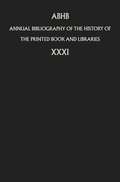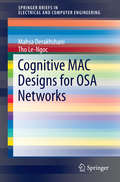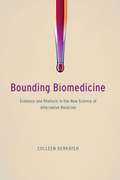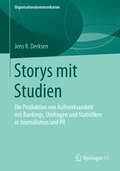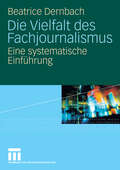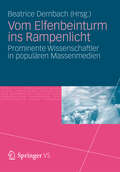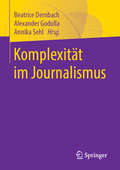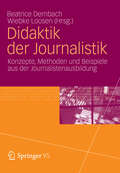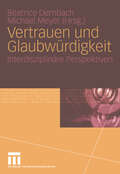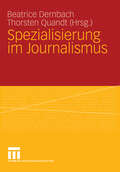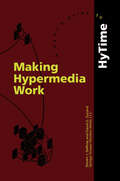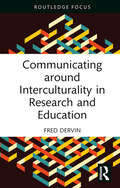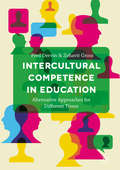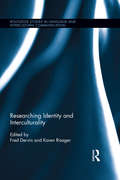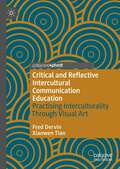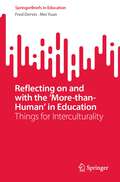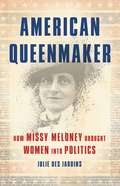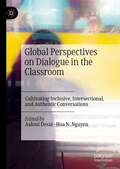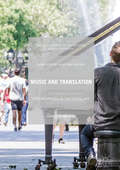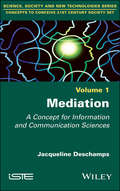- Table View
- List View
Annual Bibliography of the History of the Printed Book and Libraries: Volume 31 (Annual Bibliography of the History of the Printed Book and Libraries #31)
by Department of Information and Collections StaffThe Annual Bibliography of the History of the Printed Book and Libraries aims at recording articles of scholarly value which relate to the history of the printed book, to the history of arts, crafts, techniques and equipment, and of the economic social and cultural environment, involved in its production, distribution, conservation and description.
Cognitive MAC Designs for OSA Networks (SpringerBriefs in Electrical and Computer Engineering)
by Mahsa Derakhshani Tho Le-NgocThis SpringerBrief presents recent advances in the cognitive MAC designs for opportunistic spectrum access (OSA) networks. It covers the basic MAC functionalities and MAC enhancements of IEEE 802.11. Later chapters discuss the existing MAC protocols for OSA and classify them based on characteristic features.The authors provide new research in adaptive carrier sensing-based MAC designs tailored for OSA, which optimize spectrum utilization and ensure a peaceful coexistence of licensed and unlicensed systems. Analytically devised via optimization and game-theoretic approaches, these adaptive MAC designs are shown to effectively reduce collisions between both primary and secondary network users.Researchers and professionals working in wireless communications and networks will find this content valuable. This brief is also a useful study guide for advanced-level students in computer science and electrical engineering.
Bounding Biomedicine: Evidence and Rhetoric in the New Science of Alternative Medicine
by Colleen DerkatchDuring the 1990s, an unprecedented number of Americans turned to complementary and alternative medicine (CAM), an umbrella term encompassing chiropractic, energy healing, herbal medicine, homeopathy, meditation, naturopathy, and traditional Chinese medicine. By 1997, nearly half the US population was seeking CAM, spending at least $27 billion out of pocket. Bounding Biomedicine centers on this boundary-changing era, looking at how consumer demand shook the health care hierarchy. Drawing on scholarship in rhetoric and science and technology studies, the book examines how the medical profession scrambled to maintain its position of privilege and prestige, even as its foothold appeared to be crumbling. Colleen Derkatch analyzes CAM-themed medical journals and related discourse to illustrate how members of the medical establishment applied Western standards of evaluation and peer review to test health practices that did not fit easily (or at all) within standard frameworks of medical research. And she shows that, despite many practitioners’ efforts to eliminate the boundaries between “regular” and “alternative,” this research on CAM and the forms of communication that surrounded it ultimately ended up creating an even greater division between what counts as safe, effective health care and what does not. At a time when debates over treatment choices have flared up again, Bounding Biomedicine gives us a possible blueprint for understanding how the medical establishment will react to this new era of therapeutic change.
Bounding Biomedicine: Evidence and Rhetoric in the New Science of Alternative Medicine
by Colleen DerkatchDuring the 1990s, an unprecedented number of Americans turned to complementary and alternative medicine (CAM), an umbrella term encompassing chiropractic, energy healing, herbal medicine, homeopathy, meditation, naturopathy, and traditional Chinese medicine. By 1997, nearly half the US population was seeking CAM, spending at least $27 billion out of pocket. Bounding Biomedicine centers on this boundary-changing era, looking at how consumer demand shook the health care hierarchy. Drawing on scholarship in rhetoric and science and technology studies, the book examines how the medical profession scrambled to maintain its position of privilege and prestige, even as its foothold appeared to be crumbling. Colleen Derkatch analyzes CAM-themed medical journals and related discourse to illustrate how members of the medical establishment applied Western standards of evaluation and peer review to test health practices that did not fit easily (or at all) within standard frameworks of medical research. And she shows that, despite many practitioners’ efforts to eliminate the boundaries between “regular” and “alternative,” this research on CAM and the forms of communication that surrounded it ultimately ended up creating an even greater division between what counts as safe, effective health care and what does not. At a time when debates over treatment choices have flared up again, Bounding Biomedicine gives us a possible blueprint for understanding how the medical establishment will react to this new era of therapeutic change.
Bounding Biomedicine: Evidence and Rhetoric in the New Science of Alternative Medicine
by Colleen DerkatchDuring the 1990s, an unprecedented number of Americans turned to complementary and alternative medicine (CAM), an umbrella term encompassing chiropractic, energy healing, herbal medicine, homeopathy, meditation, naturopathy, and traditional Chinese medicine. By 1997, nearly half the US population was seeking CAM, spending at least $27 billion out of pocket. Bounding Biomedicine centers on this boundary-changing era, looking at how consumer demand shook the health care hierarchy. Drawing on scholarship in rhetoric and science and technology studies, the book examines how the medical profession scrambled to maintain its position of privilege and prestige, even as its foothold appeared to be crumbling. Colleen Derkatch analyzes CAM-themed medical journals and related discourse to illustrate how members of the medical establishment applied Western standards of evaluation and peer review to test health practices that did not fit easily (or at all) within standard frameworks of medical research. And she shows that, despite many practitioners’ efforts to eliminate the boundaries between “regular” and “alternative,” this research on CAM and the forms of communication that surrounded it ultimately ended up creating an even greater division between what counts as safe, effective health care and what does not. At a time when debates over treatment choices have flared up again, Bounding Biomedicine gives us a possible blueprint for understanding how the medical establishment will react to this new era of therapeutic change.
Bounding Biomedicine: Evidence and Rhetoric in the New Science of Alternative Medicine
by Colleen DerkatchDuring the 1990s, an unprecedented number of Americans turned to complementary and alternative medicine (CAM), an umbrella term encompassing chiropractic, energy healing, herbal medicine, homeopathy, meditation, naturopathy, and traditional Chinese medicine. By 1997, nearly half the US population was seeking CAM, spending at least $27 billion out of pocket. Bounding Biomedicine centers on this boundary-changing era, looking at how consumer demand shook the health care hierarchy. Drawing on scholarship in rhetoric and science and technology studies, the book examines how the medical profession scrambled to maintain its position of privilege and prestige, even as its foothold appeared to be crumbling. Colleen Derkatch analyzes CAM-themed medical journals and related discourse to illustrate how members of the medical establishment applied Western standards of evaluation and peer review to test health practices that did not fit easily (or at all) within standard frameworks of medical research. And she shows that, despite many practitioners’ efforts to eliminate the boundaries between “regular” and “alternative,” this research on CAM and the forms of communication that surrounded it ultimately ended up creating an even greater division between what counts as safe, effective health care and what does not. At a time when debates over treatment choices have flared up again, Bounding Biomedicine gives us a possible blueprint for understanding how the medical establishment will react to this new era of therapeutic change.
Storys mit Studien: Die Produktion von Aufmerksamkeit mit Rankings, Umfragen und Statistiken in Journalismus und PR (Organisationskommunikation)
by Jens R. DerksenMit der Berichterstattung über Studien produzieren PR-Praktiker und Journalisten routiniert öffentliche Aufmerksamkeit, die ihnen und ihren Geld- und Arbeitgebern die Durchsetztung von Interessen ermöglichen sollen. In seiner Dissertation zeigt Jens R. Derksen die Relevanz, die systematisch-empirische Erhebungen – wie wissenschaftliche Untersuchungen, Umfragen, Rankings – für die Berichterstattung von Medien und die PR von Organisationen haben. Der Autor stellt dar, welche Studien es in die Schlagzeilen schaffen und wie Medien sie thematisieren. Er analysiert Interessen von Journalisten, Medienorganisationen, PR-Praktikern und Auftraggebern und rekonstruiert Mechanismen, die dem Zustandekommen von Studien und der Berichterstattung darüber zugrunde liegen.
Die Vielfalt des Fachjournalismus: Eine systematische Einführung
by Beatrice DernbachGibt es den Fachjournalismus? Oder sind es viele Fachjournalismen, vom Reise- über den Motor- bis hin zum Medizin- und Wissenschaftsjournalismus? Seit Jahren ist beobachtbar, dass sich Journalismus inhaltlich und thematisch diversifiziert. Er reagiert damit auf den steigenden Bedarf an Spezialwissen in der Life-long-learning-Gesellschaft. Das Buch analysiert diese Entwicklung, indem es zum einen den Themenbereichen selbst und deren Widerspiegelung in der Publizistik nachforscht.
Vom Elfenbeinturm ins Rampenlicht: Prominente Wissenschaftler in populären Massenmedien
by Beatrice DernbachMänner und Frauen aus vielen Disziplinen stehen in meist persönlich geführten, etwa einstündigen Gesprächen Rede und Antwort. Sie reflektieren auch für sich selbst, was sie mit den Medien machen und wie Medien und Journalisten wiederum mit ihnen umgehen. Alle erinnern sich an Ereignisse, die sie in die Medien gebracht haben, was und woraus sie gelernt haben. Sie sprechen über ihre Erfahrungen und geben sie als Empfehlungen an Jüngere weiter.
Komplexität im Journalismus
by Beatrice Dernbach Alexander Godulla Annika SehlDie Beiträge in diesem Band analysieren die komplexen Strukturen im Journalismus und identifizieren einige seiner komplexitätsreduzierenden Strategien. In der modernen Mediengesellschaft kommt Journalismus unter anderem die Aufgabe zu, Transparenz in die gesellschaftlichen Verhältnisse zu bringen. Er erfüllt dies, indem er standardisiert und routiniert Themen selektiert, sie bearbeitet und der öffentlichen Diskussion zur Verfügung stellt. In diesem idealtypischen Verständnis versucht Journalismus, die Vielschichtigkeit und die Vernetzung vieler Ereignisse, Phänomene und sozialer Handlungen zu erklären. Die dafür notwendige Komplexitätsreduktion funktioniert in zwei Richtungen: nach innen und nach außen. Journalismus hat spezifische Strukturen und Routinen entwickelt, um die eigene und die externe Komplexität zu minimieren und damit handlungsfähig zu sein. Der InhaltKomplexitätsforschung ● (Theoretische) Komplexität des Journalismus ● Komplexität journalistischer Binnenstrukturen ● Komplexitätsreduktion in digitalen journalistischen Angeboten ● Journalistische Komplexitätsreduktion in Themenfeldern Die HerausgeberDr. Beatrice Dernbach ist Professorin für „Praktischer Journalismus“ an der Technischen Hochschule Nürnberg und seit den 1990er Jahren in der Journalismusforschung und der akademischen Journalistenausbildung aktiv.Dr. Alexander Godulla ist Professor für Empirische Kommunikations- und Medienforschung am Institut für Kommunikations- und Medienwissenschaft der Universität Leipzig.Dr. Annika Sehl ist Professorin für Digitalen Journalismus am Institut für Journalistik der Universität der Bundeswehr München und Research Associate am Reuters Institute for the Study of Journalism der University of Oxford.
Didaktik der Journalistik: Konzepte, Methoden und Beispiele aus der Journalistenausbildung.
by Beatrice Dernbach Wiebke LoosenSeit vielen Jahren wird darüber diskutiert, dass die journalistische Aus- und Weiterbildung gleichermaßen Theorie und Praxis braucht. In dem Herausgeberband wird vor dem Hintergrund dieser Diskussion gezeigt, mit welchen didaktischen Konzepten sowohl theoretische, methodische und praktische Kenntnisse und Fähigkeiten in unterschiedlichen Ausbildungseinrichtungen (vor allem Hochschulen und Akademien) vermittelt werden. Entstanden ist daraus ein Überblick von Best-Practice-Beispielen aus der Journalistenausbildung, in dem Journalistenausbilderinnen und -ausbilder aus Wissenschaft und Praxis Ideen, Ziele, Vorgehensweisen und Methoden ihrer Lehre vorstellen.
Vertrauen und Glaubwürdigkeit: Interdisziplinäre Perspektiven
by Beatrice Dernbach Michael MeyerVertrauenswürdigkeit von öffentlichen Personen und Institutionen ist für jeden Einzelnen ein wichtiges Kriterium und größtes Problem bei der Meinungsbildung. Eine Diskussion aus der Sicht der Psychologie, der Publizistik, der Politik, der Wirtschaft, der Philosophie, des Rechts und der Kunst kann helfen, aus wechselseitigen Perspektiven neue und übergreifende Einsichten in die Funktion von Vertrauen für die Beziehungen zwischen Personen und Institutionen zu gewinnen.
Spezialisierung im Journalismus
by Beatrice Dernbach Thorsten QuandtAuf die immer stärkere Ausdifferenzierung des Publikums in kleinere und kleinste Interessengruppen reagiert der Journalismus mit einer zunehmenden Spezialisierung: Nahezu jedes vermutete oder offenkundige Publikumsinteresse wird mit publizistischen Angeboten in jeder denkbaren Form bedient. So findet man im Printbereich neben klassischen Allround-Titeln für Wirtschaft, Sport, Politik und Kultur auch Very-special-interest- und Fach-Publikationen für den Geldanleger, den Jazzliebhaber, den Segler, den Angler, den Uhrenfan. Im Internet boomen immer spezialisiertere Webseiten und Blogs. Und auch das Fernsehen entdeckt zunehmend kleinere Nischen und Sparten. Mit den positiven wie negativen Aspekten dieser Spezialisierung setzt sich der vorliegende Sammelband sowohl aus wissenschaftlicher als auch aus praxis-bezogener Sichtweise auseinander.
Making Hypermedia Work: A User’s Guide to HyTime
by S.J. DeRose D. DurandMaking Hypermedia Work: A User's Guide to HyTime discusses how the HyTime standard can be applied to real world problems of navigating from here to there in collections of documents. The HyTime standard itself provides enabling method and templates for various information structures such as links and various kinds of location indicators. A HyTime application specifies how a group applies those templates to their particular requirements. This involves choosing which HyTime structures are needed, setting up conventions for how they are to be used and setting up management and processes for creation, conversion and update of hypermedia documents. A HyTime engine is the last ingredient: actually using an application typically involves choosing software to support one's use of HyTime and customizing it as needed. This may be as simple as setting up hypertextual style sheets that determine how links and other things look and act. More specialized applications may require full-scale design and programming. Making Hypermedia Work: A User's Guide to HyTime presents the first in-depth guide to the HyTime specifications, both describing its key features and providing guidelines on how it is used. The book begins with the more familiar structures of books, graphics and cross-references, detailing the HyTime constructs and models used to identify, locate, and link data. It goes on to introduce some of HyTime's mechanisms for linking multidimensional, multimedia data, and for scheduling it in space and time. The authors help the reader become fluent in HyTime as it applies to the simpler and most widely understood data types. After mastering this level of HyTime, readers will be ready and able to explore the exciting potential of HyTime for more sophisticated multimedia applications.
Communicating around Interculturality in Research and Education (New Perspectives on Teaching Interculturality)
by Fred DervinThis book does not instruct the reader how to communicate interculturally but supports them in reflecting on how they can (re-)negotiate and (re-)construct knowledge(s), ideologies and relations around the notion of interculturality. Anchored in the author’s original and thought-provoking perspectives on interculturality, this interdisciplinary and global-minded book explores how communicating around the notion cannot do away with ideologisms, issues of language and translation or the problematization of voice and silence in research and education. Written in an original and stimulating way, relying on different writing genres and styles to ‘mimic’ the dynamism and flexibility of the very notion under review, the author urges us to (un-)voice, scrutinize, nurture and galvanize our ways of dealing with interculturality alone and together with others in academia. The very specific focus of the book, communicating around interculturality (instead of ‘doing’ interculturality), represents a fresh and important move for observing, analyzing, speaking of and contributing to today's complex and divided world. The title is aimed at researchers, students and educators interested in examining and enriching their own takes on interculturality, from a more reflexive and interactive perspective.
Communicating around Interculturality in Research and Education (New Perspectives on Teaching Interculturality)
by Fred DervinThis book does not instruct the reader how to communicate interculturally but supports them in reflecting on how they can (re-)negotiate and (re-)construct knowledge(s), ideologies and relations around the notion of interculturality. Anchored in the author’s original and thought-provoking perspectives on interculturality, this interdisciplinary and global-minded book explores how communicating around the notion cannot do away with ideologisms, issues of language and translation or the problematization of voice and silence in research and education. Written in an original and stimulating way, relying on different writing genres and styles to ‘mimic’ the dynamism and flexibility of the very notion under review, the author urges us to (un-)voice, scrutinize, nurture and galvanize our ways of dealing with interculturality alone and together with others in academia. The very specific focus of the book, communicating around interculturality (instead of ‘doing’ interculturality), represents a fresh and important move for observing, analyzing, speaking of and contributing to today's complex and divided world. The title is aimed at researchers, students and educators interested in examining and enriching their own takes on interculturality, from a more reflexive and interactive perspective.
Intercultural Competence in Education: Alternative Approaches for Different Times
by Fred Dervin Zehavit GrossThis book explores the concept of intercultural competence, focusing specifically on education. Intercultural competence can vary depending on the field of research or the context of application and has therefore developed over recent decades. As the world becomes increasingly global intercultural competence has become even more important but it is still not practiced satisfactorily. This book highlights views which are at odds with official and orthodox positions on intercultural competence to encourage fresh approaches to intercultural competence. It will be invaluable for researchers, practitioners and students interested in the global possibilities of education.
Researching Identity and Interculturality (Routledge Studies in Language and Intercultural Communication #3)
by Fred Dervin Karen RisagerThis volume focuses on advances in research methodology in an interdisciplinary field framed by discourses of identity and interculturality. It includes a range of qualitative studies: studies of interaction, narrative studies, conversation analysis, ethnographic studies, postcolonial studies and critical discourse studies, and emphasizes the role of discourse and power in all studies of identity and interculturality. The volume particularly focuses on critical reflexivity in every stage of research, including reflections on theoretical concepts (such as ‘identity’ and ‘interculturality’) and their relationship with methodology and analytical practice, reflections on researcher identity and subjectivity, reflections on local and global contexts of research, and reflections on language choice and linguacultural aspects of data generation, analysis and communication.
Researching Identity and Interculturality (Routledge Studies in Language and Intercultural Communication)
by Fred Dervin Karen RisagerThis volume focuses on advances in research methodology in an interdisciplinary field framed by discourses of identity and interculturality. It includes a range of qualitative studies: studies of interaction, narrative studies, conversation analysis, ethnographic studies, postcolonial studies and critical discourse studies, and emphasizes the role of discourse and power in all studies of identity and interculturality. The volume particularly focuses on critical reflexivity in every stage of research, including reflections on theoretical concepts (such as ‘identity’ and ‘interculturality’) and their relationship with methodology and analytical practice, reflections on researcher identity and subjectivity, reflections on local and global contexts of research, and reflections on language choice and linguacultural aspects of data generation, analysis and communication.
Critical and Reflective Intercultural Communication Education: Practicing Interculturality Through Visual Art
by Fred Dervin Xiaowen TianThis book provides answers to the following questions: How could visual art support us in reflecting about interculturality critically? When we look at, engage with and experience art, what is it that we can learn, unlearn and relearn about interculturality? The book adds to the multifaceted and multidisciplinary field of intercultural communication education by urging those working on the notion of interculturality (researchers, scholars and students) to give art a place in exploring its complexities. No knowledge background about art (theory) is needed to work through the chapters. The book helps us reflect on ourselves and on our engagement with the world and with others, and learn to ask questions about these elements. The authors draw on anthropology, linguistics, philosophy and sociology to enrich their discussions of critical interculturality.
Reflecting on and with the ‘More-than-Human’ in Education: Things for Interculturality (SpringerBriefs in Education)
by Fred Dervin Mei YuanThis book examines today’s central and yet often misunderstood and misconstrued notion of interculturality. It specifically focuses on one aspect of intercultural awareness that has been ignored in research and education: the presence and influence of things on the way we experience, do, and reflect on interculturality. This book provides the readers with opportunities to engage with interculturality by reflecting on how our lives are full of things and entangled with them. It urges teachers, teacher educators, scholars, and students to open their eyes to the richness that the more-than-human, with which we can reflect, has to offer for intercultural communication education.
American Queenmaker: How Missy Meloney Brought Women Into Politics
by Julie Des JardinsThe first biography of Missy Meloney, the most important woman you've never heard of Marie "Missy" Mattingly Meloney was born in 1878, in an America where women couldn't vote. Yet she recognized the power that women held as consumers and family decision-makers, and persuaded male publishers and politicians to take them seriously. Over the course of her life as a journalist, magazine editor-in-chief, and political advisor, Missy created the idea of the female demographic. After the passage of the 19th Amendment she encouraged candidates to engage with and appeal to women directly. In this role, she advised Presidents from Hoover and Coolidge to FDR. By the time she died in 1943, women were a recognized political force to be reckoned with.In this groundbreaking biography, historian Julie Des Jardins restores Missy to her rightful place in American history.
Global Perspectives on Dialogue in the Classroom: Cultivating Inclusive, Intersectional, and Authentic Conversations
by Ashmi Desai Hoa N. NguyenThis book explores globally-informed, culturally-rooted approaches to dialogue in the classroom. It seeks to fill gaps in communication and education literature related to decolonizing dialogue and breaking binaries by decentering Eurocentric perspectives and providing space for dialogic practices grounded in cultural wealth of students and teachers. We first describe the book’s genesis, contextualize dialogue within the global impact of the COVID-19 pandemic, and share guiding concepts of inclusion, intersectionality, and authenticity in dialogue and pedagogy. We also distinguish dialogue from other practices and times in which dialogue may not be possible. The book brings fresh and urgent perspectives from authors across different disciplines, including ceramics, religious studies, cultural studies, communication, family therapy, and conflict resolution. The chapters distill the idea of dialogue within contexts like a bible circle, university sculpture studio, trauma and peacebuilding program, and connect dialogue to teaching, learning, and emerging ideas of power disruption, in-betweenness, and relationality.
Music and Translation: New Mediations in the Digital Age (Palgrave Studies in Translating and Interpreting)
by Lucile DesblacheThis book explores how transformations and translations shape musical meanings, developments and the perception of music across cultures. Starting with the concept of music as multimodal text, the author understands translation as the process of transferring a text from one language – verbal or not – into another, interlingually, intralingually or intersemiotically, as well as the products that are derived from this process. She situates music and translation within their contemporary global context, examining the tensions between local and global, cosmopolitan and national, and universal and specific settings, to arrive at a celebration of the translational power of music and an in-depth study of how musical texts are translated. This book will be of interest to translation studies scholars who want to broaden their horizons, as well as to musicians and music scholars seeking to understand how cultural exchange and dissemination can be driven by translation.
Mediation: A Concept for Information and Communication Sciences
by Jacqueline DeschampsMediation is a very old practice that has been reborn to meet the needs of the contemporary world. It is thus increasingly present in today's societies. This book presents the theoretical foundations of mediation, as well as the way in which teachers and researchers in Information and Communication Sciences (ICS) have taken up this concept. Whether it is communicational, informational, cultural, organizational or societal, mediation belongs to a field of research, instituted by ICS, which sees in it a process of overcoming conflict, restoring communication and deconstructing social connections. Mediation: A Concept for Information and Communication Sciences inaugurates this set through its contribution to a state of the art of the theory and concepts used by the ICS community. It is addressed to teachers, researchers and students, as well as information professionals wishing to think about their daily practice.
